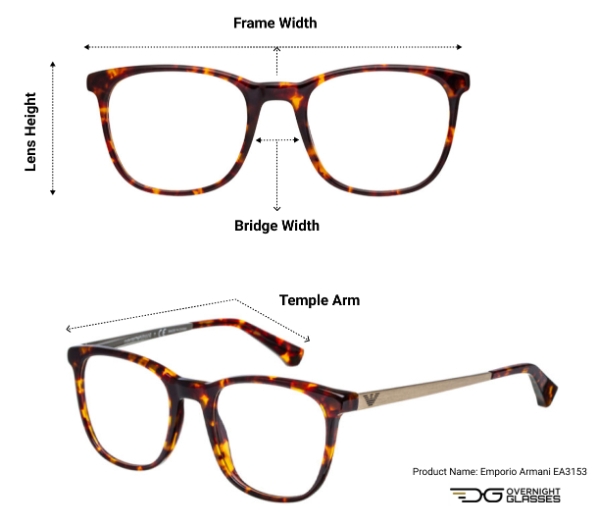Glasses measurements
What Is Your Frame Size?
There are several measurements to be aware of because they are useful in understanding the lens requirements of your prescription as well as understanding how to find eyeglass frames that will be comfortable and fit the wearer’s face.
Additionally, while a brick and mortar shop might be able to figure out measurements for their shoppers, most people appreciate the freedom and safety of online shopping. By knowing how to look up personal measurements any shopper is then empowered to choose the best frames during their online eyeglasses retail purchase.
Bridge width
The bridge width is the distance between the lenses of your eyeglass frames. Many confuse this measurement to be the width of the bridge of the nose or a measure of the space between the eyes. Instead, the bridge width is the size of the frames that holds the lenses. Sizes are standardized, so they range from 14mm to 24mm.
Lens Height
The height of the lenses refers to the vertical measurement of eyeglass lenses. It’s measured from the widest point of the lens within the frame. Because the very edge of the lens is covered by the frames, it matters whether the measurement is taken while the lenses are in the frame or not. They must be in the frames to get an accurate measurement. Always measure at the widest point of the lenses while they are in the frames. This measurement is particularly useful when measuring for bifocals or progressives.
Lens Width
The width of the lenses are, again, measured while they are in the frames. If you have removable lenses, don’t take them out when measuring because these measurements take into account that the very edge of the lenses will be encased in the frame. Measure the horizontal width at the widest point. Measurements are standardized, so they will range from 40mm to 60mm.
Temple (Arm) Length
The arm is the piece of the frame that reaches from your temple to bend and rest on your ear. When capturing this measurement be sure to measure from the screw at the temple tip to the very end of the arm, including the end where it bends to fit over your ear. These measurements are also standardized and will always fall between 120mm and 150mm long.
Temple-to-Temple
Glasses companies will not place this measurement on the inside of the frames. It’s a measurement you would need to take yourself. It can be useful, however, because it tells you about the actual fit of the frames on the face. Find out how to capture this measurement below.
Find Your Size On Your Current Frames
Rather than ordering a pair of glasses and hoping they’ll fit, it’s useful to go shopping armed with your correct measurements. Even if you can’t find the exact same frames, you’ll be able to find something similar with the same measurements. Or you’ll be able to custom order frames with confidence because you knew your measurements.
First let’s talk about the numbers that are typically the easiest to identify. Look for a set of three numbers. The first will be the lens width. More often than not, you’ll see a small square between the first and second number. Then you’ll see two numbers separated by a dash. Those are the bridge width and temple length.
For example, if you see 48 ▢ 22-138, you know you’ve found the correct set of numbers. The number 48 is the lens width. The number 22 is the bridge width. And after the dash, you’ll see a three digit number, which is the temple (arm) length.
It’s worth noting that out of all those numbers, the temple length is the most flexible. For design and engineering reasons, many eyeglasses will have a great deal of variety in temple (arm) length, but slightly longer or shorter measurements may still be very comfortable.
If there are other numbers carved or stamped on the inside of your frames, these are most likely the manufacturer’s model number. These are typically alphanumeric amounting to some combination of the brand name and the model number. There may also be a few other alphanumeric identifying details, such as a color code, the name of the line of glasses.

Determine Your Frame Size By Yourself:
Too often, a wearer will finally need a new pair of glasses, but by the time they decide to go ahead and retire their old frames, the numbers have been rubbed off over time. Or maybe the glasses never had the numbers printed on them in the first place. This would be uncommon but not unheard of.
Luckily, measurements are standardized and always taken in millimeters (mm). That means you can use a ruler with millimeter markings to determine the measurements yourself.
It’s worth noting that a fabric measuring tape, such as those used to take body measurements by a seamstress, may be preferable because you’ll be able to capture the complete measurement along with any curve of the lens or of the arm as it bends over the ear. You can still use a metal measuring tape, or a regular ruler. These options may just mean you are capturing an approximate measurement.
Recall that the temple- to-temple measurement will not be available on the frames and will need to be captured manually. This measurement will tell you about the best fit of your frames to your face. Place the frames on a flat surface with the arms straight, rather than folded. Measure the distance from one arm across to the other arm, at the temple. This tells you how wide your frames need to be to comfortably fit the width of your face.
The temple-to-temple measurement is also an especially useful number if you are trying to measure lenses in a wrapped frame. In a wrapped frame, the lenses actually bend around the face a bit. This can make the lens width difficult to measure. And it can distort the measurement of the lens width slightly, making it seem like your lens width is a larger number than it needs to be for regular glasses that are not wrapped frames.
Find The Perfect Glasses Using Frame Size Measurements
While it can feel challenging and a bit overwhelming to find the right glasses, shopping is easier when you have a better understanding of size.
Begin with the measurements of your glasses. This is a great starting place when trying to understand the ideal size of your new glasses. Just base the size on your current glasses. Remember to find your lens width, bridge width, lens height, and temple (arm) length.
Once you’ve captured those, most likely from the inscription on the inside of your glasses, consider also taking the temple-to-temple measurement of your glasses. This will give you even more clarity and a better sense of frames that will fit your face.
Then decide whether you have a large, medium, or small head. You can use this measurement along with your temple-to-temple measurement. Or choose small, medium, and large as a measurement instead of the temple-to-temple measure. It depends on the sizes available at your retailer. Generally, you will know where you fit among these sizes. Petite people will often choose small frames, or even child/teen frames. Most large people know whether they also need large frames. Ultimately if you aren’t sure, it’s safe to go with medium frames. Most frames are made for the average size head. Medium or mid-range frames are typically a safe choice.
Ultimately, it might even be a good idea to reach out to customer service and ask about the frames. You can double check whether the frames you are interested in tend to run large or small. And you can check on the return or exchange policy so you know how long you have to try your frames once they’ve arrived. And it may be useful to get clarity on any options the company has to customize your frames. Some companies are able to customize frames as well as lenses, but be aware that customization can come with an added fee and may take longer to manufacture.

